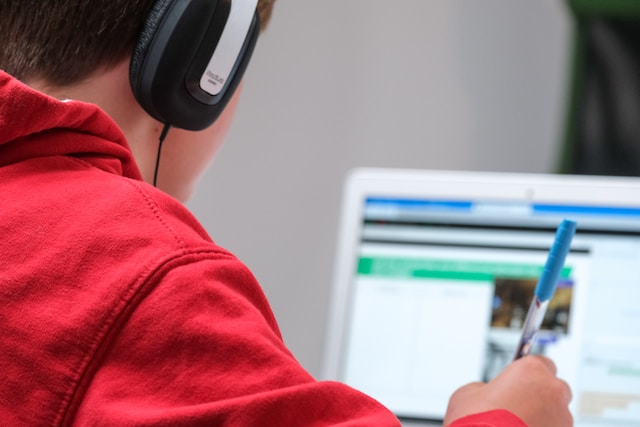Music instruction involves sound that is produced in real-time. Computers can make this process efficient, but does it work as well? The short answer is that It depends on your goals and your motivation. There are pros and cons to both types of instruction.
During the pandemic, I taught orchestra online for a year. I taught private and small group lessons. I took lessons myself remotely with teachers online. Finally, I sang in a Zoom choir. So I got to experience online learning both as a teacher and a student. This gave me lots of insights into how to make the best of the options that are available to us now.
First, a few definitions. With both online and in-person music instruction, there are many different types of music-making. We need some definitions of the different kinds of music-making you might be doing. These definitions will make clear the advantages and disadvantages of in-person and online instruction.
In-Person Instruction
You can either take lessons one-on-one or in a group. When we think of music instruction, we often think of private lessons. Private lessons are great if you want the individual attention of your teacher. These lessons work well in both a remote and an in-person setting.
You can also elect for small-group lessons. Small-group lessons are great because you are doing something you enjoy with a friend. There can be great social interaction and the opportunity to play together. You can develop great ensemble skills. These lessons work better in person for ensemble playing. But they can work online with a supportive group of people.
Finally, there are large groups. Think of your traditional band, orchestra, or choir. These groups can have 25-100 people in them. There is not a lot of individual attention. But you are part of a team and make beautiful music together. You make lifelong friends from being in a performing ensemble together. These rehearsals do NOT work well remotely.
Online Instruction
Online music instruction can replicate some of what we see in these three modes of in-person music-making. A private online lesson is every bit as engaging as an in-person lesson.
When you have groups of people in a Zoom setting, musicians can play for each other and get feedback either from the teacher or from other students. The teacher can start a session with guided practice and instruction. Then, students can play for each other to show what they have learned. With the use of backing tracks and guidance from the teacher, participants can stay motivated and learn a lot. This kind of online setting is like a small group lesson.
Finally, there are sessions that are asynchronous. Think of people sitting at home learning how to play an instrument with YouTube videos or an online course. You can be successful with this kind of instruction, but you aren’t going to get as much individual attention.
Some teachers use this kind of instruction for a personalized learning experience. Students watch videos to learn a new skill. Then they practice the new skills. Finally, they record themselves and send the recording to their teacher. The teacher gives feedback to the student. The student gets individual attention and the timing is convenient to both parties.
I noticed many things with online music teaching. It works well with motivated students. It did not work well in a large ensemble setting. Here is what I noticed during my remote teaching sessions during the past few years.
Pros of Online Music Instruction
- No travel time – This can be especially convenient if you’re a parent who drives children to many different activities after school.
- Ease of scheduling – You and your teacher can be quite flexible about lesson times. You can participate asynchronously and email a video to your teacher for feedback.
- More flexibility – You can still attend a lesson if you’re not feeling well.
- Easy of Online Resources – Your teacher can get online resources to you easily.
- Screen-Sharing Both you and your teacher can share the screen. That way if you don’t understand a concept, it’s easy to focus on it with the screen share tool.
- Geographically Unlimited – You can study with any teacher whether you live close to them or not
Cons of Online Music Instruction
- No Physical Contact – The instructor is not able to physically correct the student. Setting up the correct posture is more difficult.
- Computer Lag Time – The student and the teacher can’t play together. The lag time of the computer makes this impossible.
- Sound Quality – The sound quality of the instrument is not as good as it is in person.
- Social Interaction – There is less social interaction with other students.
- Rhythmic Sense and Ensemble Skills – It’s more difficult to learn rhythmic feeling if you are playing by yourself.
So, you need to think about what works best for you and your students. If you value flexibility and the ability to work with someone outside of your geographical area, online instruction will work for you.
If you want social interaction or to make music with others, in person will be best. If you want to play duets with your teacher, in-person will be best for you.
Think of your goals. With our use of computers both online and in-person music instruction can offer great learning opportunities. The choice is yours. If you are dedicated to getting better at your instrument, either mode of instruction will work wonders for you!
Click Below to Learn More About Lessons
Jenny guides you to find your musical self. You can learn piano, violin, viola, or ukulele.
